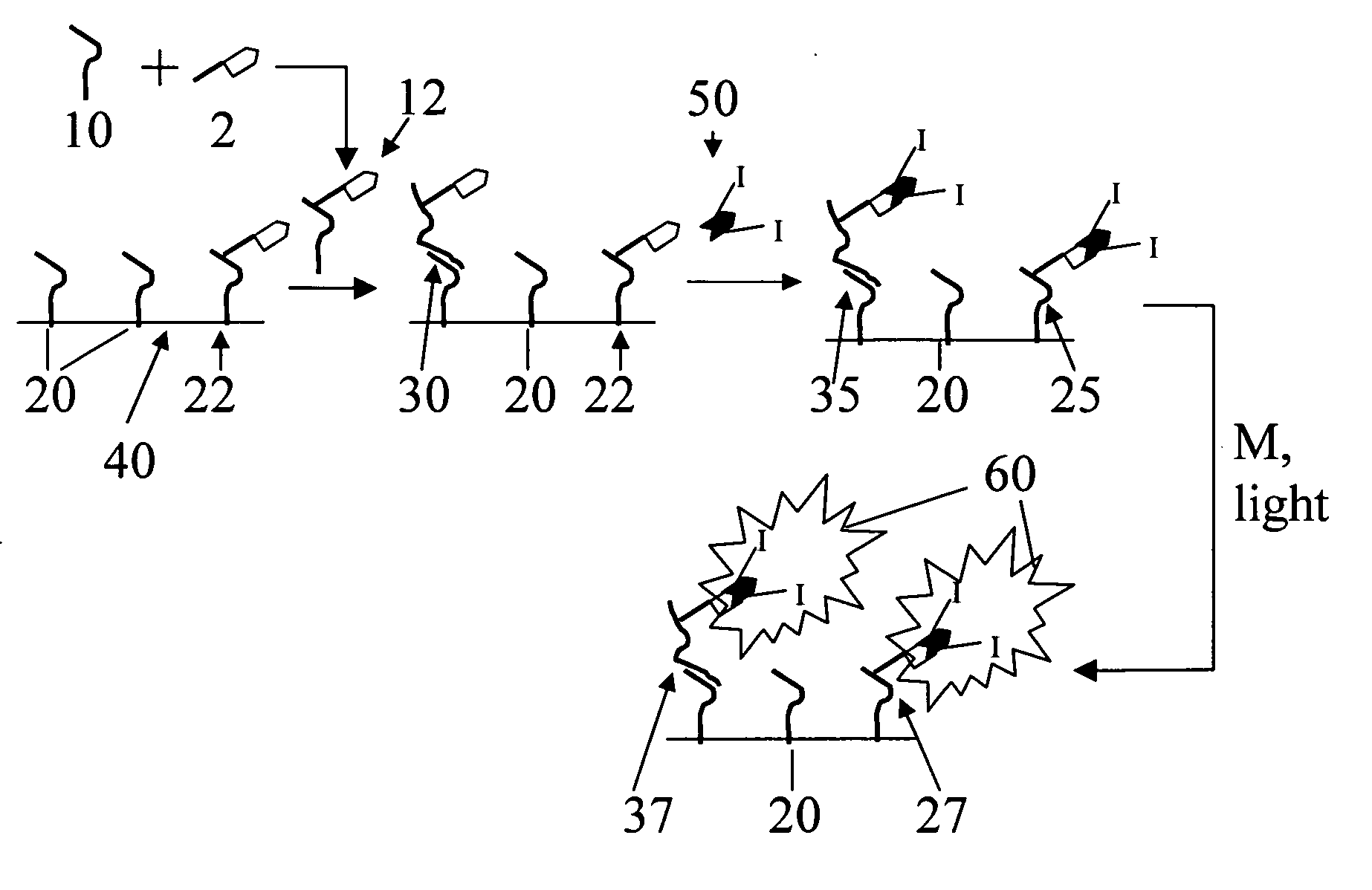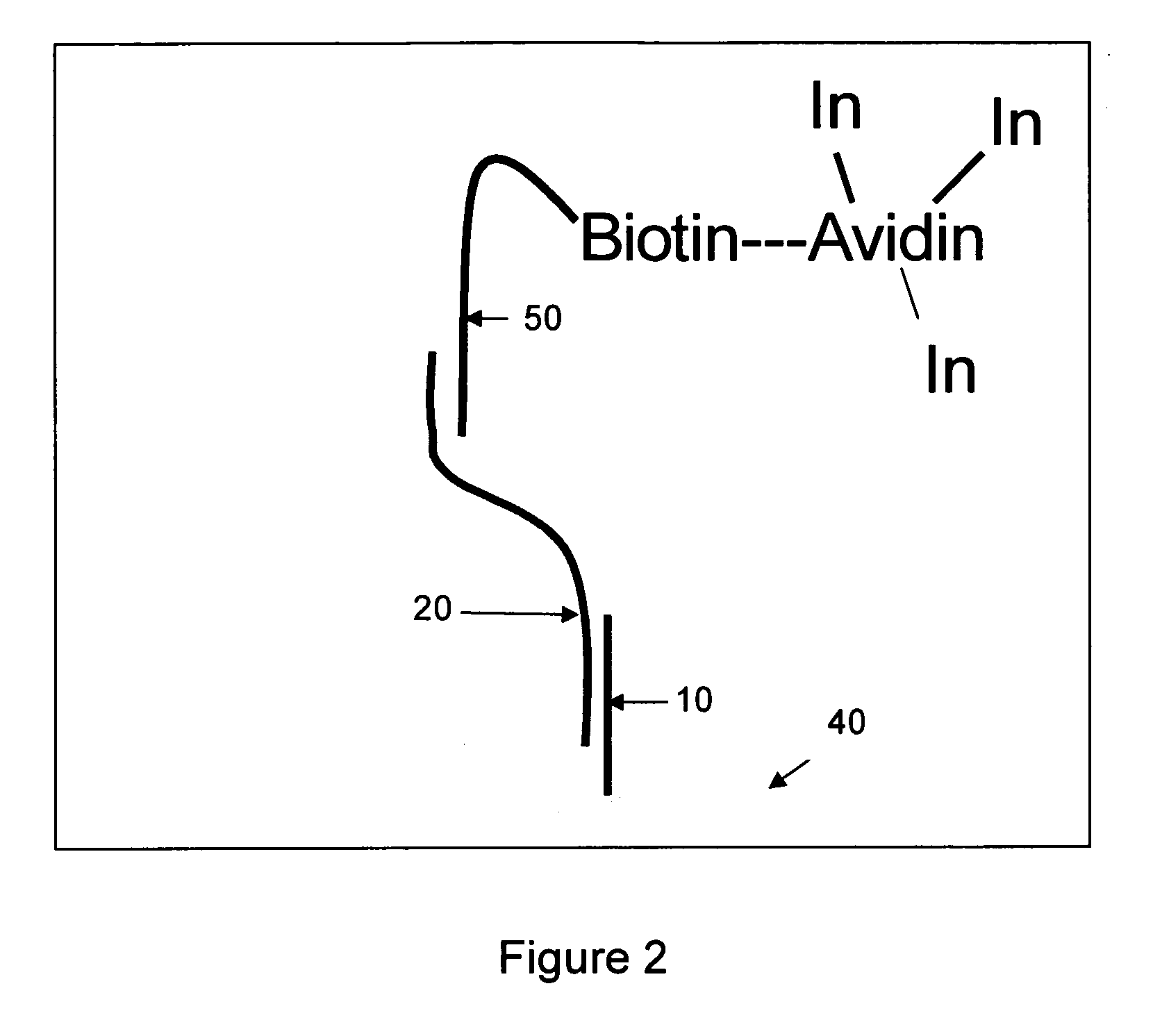Use of photopolymerization for amplification and detection of a molecular recognition event
a molecular recognition and photopolymerization technology, applied in the field can solve the problems of increasing the difficulty of detection of molecular recognition events such as dna hybridization, increasing the cost of rca, and increasing the necessity of dna polymerase, so as to increase the number of recognition events
- Summary
- Abstract
- Description
- Claims
- Application Information
AI Technical Summary
Benefits of technology
Problems solved by technology
Method used
Image
Examples
example 1
Synthesis of a Water Soluble Initiator
[0108]
[0109] As shown in Scheme 1, synthesis of a water soluble photoinitiator (preferred for compatibility with a BioChip) was achieved by starting with commercially available Irgacure 2959 (left most structure, Ciba Specialty Chemicals (http: / / www.cibasc.com)). Irgacure 2959 was dissolved / suspended in chloroform along with succinic anhydride and a catalytic amount of 4-dimethylaminopyridine. The solution was refluxed, with stirring, for 12 hours at 65° C. In both chloroform and water, the product was soluble while the starting materials were sparingly soluble. The product structure was verified by NMR and shown to function as a photoinitiator by monitoring the double bond conversion of an acrylate monomer using time-resolved FTIR.
example 2
Functionalization of Avidin with Photoinitiator
[0110]
[0111] Avidin is often labeled with dye molecules by modification of its many lysine residues (for example, Pierce Biotechnology sells a kit for this purpose). These types of modifications do not disrupt avidin's ability to bind to biotin (Wilbur, D. S.; Hamlin, D. K.; Buhler, K. R.; Pathare, P. M.; Vessella, R. L.; Stayton, P. S.; To, R. (1998) “Streptavidin in antibody pretargeting. 2. Evaluation of methods for decreasing localization of streptavidin to kidney while retaining its tumor binding capacity”Bioconjugate Chemistry 9: 322-330). Here, as shown in Scheme 2, the lysine residues have been modified with a photoinitiator (rather than a dye) by coupling the carboxylic acid functional group of the photoinitiator to the amine of the lysine residue. The result is formation of a peptide bond between the initiator and the protein. Avidin and an excess of the initiator (the product in Scheme 1, represented by In in Scheme 2) were ...
example 3
Synthesis of a Polymer Labeled with Photoinitiator and Streptavidin
[0112]
[0113] Scheme 3 illustrates the formation of a polymer labeled with Irgacure 2959 photoinitiator (denoted by I) and streptavidin (denoted by
[0114] Macroinitiators were synthesized using poly(acrylic acid-co-acrylamide) (MW=200,000 g / mol), Irgacure 2959, and streptavidin as starting materials. The water-soluble coupling agent 1-ethyl-3-[3-dimethylaminopropyl]carbodiimide (EDC) and the intermediate-stabilizing molecule N-hydroxsuccinimide (NHS) were used to create amide linkages between some of the acrylic acid subunits and streptavidin and to create ester linkages between other acrylic acid subunits and the initiator Irgacure 2959 (12959). Still other acrylic acid subunits were left unmodified to assure the water solubility of the resulting macroinitiator. Two types of reaction conditions were varied in order to change the number of initiators that coupled per chain. First, the stoichiometry of reactants was v...
PUM
| Property | Measurement | Unit |
|---|---|---|
| thick | aaaaa | aaaaa |
| thick | aaaaa | aaaaa |
| spot size | aaaaa | aaaaa |
Abstract
Description
Claims
Application Information
 Login to View More
Login to View More - R&D
- Intellectual Property
- Life Sciences
- Materials
- Tech Scout
- Unparalleled Data Quality
- Higher Quality Content
- 60% Fewer Hallucinations
Browse by: Latest US Patents, China's latest patents, Technical Efficacy Thesaurus, Application Domain, Technology Topic, Popular Technical Reports.
© 2025 PatSnap. All rights reserved.Legal|Privacy policy|Modern Slavery Act Transparency Statement|Sitemap|About US| Contact US: help@patsnap.com



